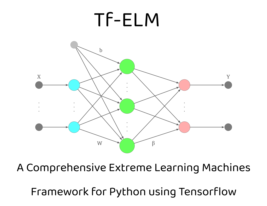Multi-layer Extreme Learning Machine (MELM) model.
MELMModel is a multi-layer variant of Extreme Learning Machine (ELM) model,
consisting of multiple layers, each with its own computational units.
Parameters:
-----------
layers (list, optional): List of layers. Defaults to None.
verbose (int, optional): Verbosity level. Defaults to 0.
verbose (int): Verbosity level.
Controls the amount of information printed during model fitting and prediction.
Attributes:
-----------
classes_ (array-like): The classes labels.
Initialized to None and populated during fitting.
Examples:
-----------
Create a Multilayer ELM model
>>> model = MELMModel()
Add 3 layers of neurons
>>> model.add(ELMLayer(number_neurons=1000, activation='mish', C=10))
>>> model.add(ELMLayer(number_neurons=2000, activation='mish', C=10))
>>> model.add(ELMLayer(number_neurons=1000, activation='mish', C=10))
Define a cross-validation strategy
>>> cv = RepeatedKFold(n_splits=10, n_repeats=50)
Perform cross-validation to evaluate the model performance
>>> scores = cross_val_score(model, X, y, cv=cv, scoring='accuracy', error_score='raise')
Print the mean accuracy score obtained from cross-validation
>>> print(np.mean(scores))
Fit the ELM model to the entire dataset
>>> model.fit(X, y)
Save the trained model to a file
>>> model.save("Saved Models/MELM_Model.h5")
Load the saved model from the file
>>> model = model.load("Saved Models/MELM_Model.h5")
Evaluate the accuracy of the model on the training data
>>> acc = accuracy_score(model.predict(X), y)
| MELMModel.MELMModel.fit |
( |
| self, |
|
|
| x, |
|
|
| y ) |
Fit the MELM model to input-output pairs.
This method trains the MELM model by iteratively fitting each layer in the model.
During the training process, input data is propagated through each layer.
Args:
-----------
x (array-like): Input data.
y (array-like): Output data.
Examples:
-----------
Create a Multilayer ELM model
>>> model = MELMModel()
Add 3 layers of neurons
>>> model.add(ELMLayer(number_neurons=1000, activation='mish', C=10))
>>> model.add(ELMLayer(number_neurons=2000, activation='mish', C=10))
>>> model.add(ELMLayer(number_neurons=1000, activation='mish', C=10))
Fit the ELM model to the entire dataset
>>> model.fit(X, y)
| MELMModel.MELMModel.predict |
( |
| self, |
|
|
| x ) |
Predict the output for input data.
This method predicts the output for the given input data by propagating
it through the layers of the MELM model.
Args:
-----------
x (array-like): Input data.
Returns:
-----------
array-like: Predicted output.
Examples:
-----------
Create a Multilayer ELM model
>>> model = MELMModel()
Add 3 layers of neurons
>>> model.add(ELMLayer(number_neurons=1000, activation='mish', C=10))
>>> model.add(ELMLayer(number_neurons=2000, activation='mish', C=10))
>>> model.add(ELMLayer(number_neurons=1000, activation='mish', C=10))
Fit the ELM model to the entire dataset
>>> model.fit(X, y)
Evaluate the accuracy of the model on the training data
>>> acc = accuracy_score(model.predict(X), y)
| MELMModel.MELMModel.predict_proba |
( |
| self, |
|
|
| x ) |
Predict class probabilities for input data.
This method predicts class probabilities for the given input data
by propagating it through the layers of the MELM model and applying softmax.
Args:
-----------
x (array-like): Input data.
Returns:
-----------
array-like: Predicted class probabilities.
Examples:
-----------
Create a Multilayer ELM model
>>> model = MELMModel()
Add 3 layers of neurons
>>> model.add(ELMLayer(number_neurons=1000, activation='mish', C=10))
>>> model.add(ELMLayer(number_neurons=2000, activation='mish', C=10))
>>> model.add(ELMLayer(number_neurons=1000, activation='mish', C=10))
Fit the ELM model to the entire dataset
>>> model.fit(X, y)
Evaluate the prediction probability of the model on the training data
>>> pred_proba = model.predict_proba(X)


